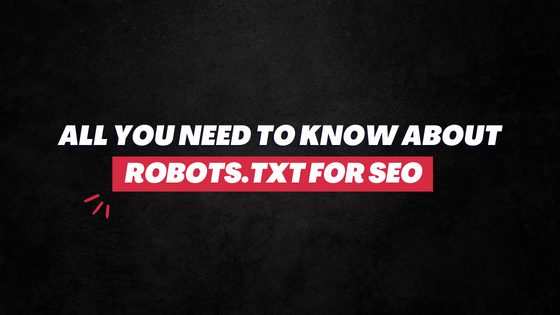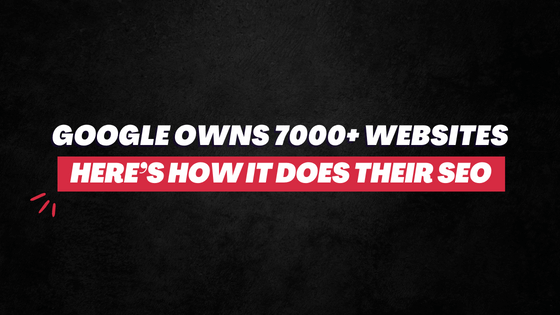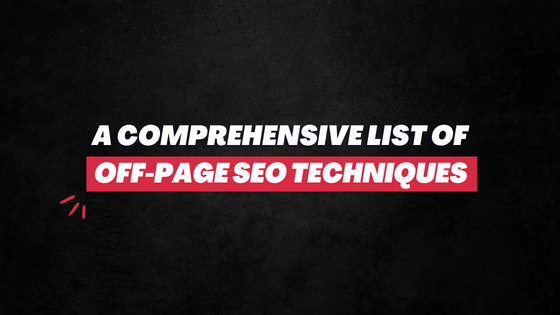
Google loves content that humans love.
Humans will love content only when they find it on Google in the first place.
SEO writing is a skill that helps your content rank higher on Search Engine Result Pages (SERPs).
So, if you’re wondering how to create content that Google adores and rewards, this post will teach you exactly that.
You will learn how to be good at SEO-friendly writing.
By the end of the post, you will know how to be a superstar SEO content writer who understands the dynamic of search ranking.
Let’s dive in…
…don’t let such suggestions and conflicting opinions confuse you…

“Is SEO writing dead?”
I assure you, it is not.
If anything, with more competition across industries and more people shelling generic articles, the importance of writing SEO-friendly content is more than ever.
So, neither is SEO dead…
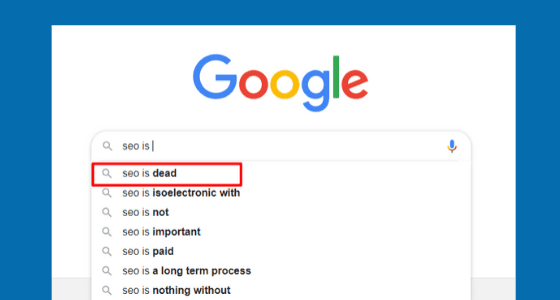
…nor is SEO writing! 😉
What is SEO Writing?
In layman’s term…It is basically creating content that Google believes is fitting for what a user is looking for.
It is creating content that are optimized around the search ranking factors that Google will find relevant and then rank higher.

Elisa Gabbert puts it very well on Wordstream…
“SEO content is any content created with the goal of attracting search engine traffic.”
SEO content (articles, blog posts, webpages, sales pages) incorporate proper keywords, formatting, images and other components to be effectively optimized.
The primary intent is to generate organic search traffic.
But, of course, the content can also be used for branding and sales purposes.
Now, before we jump to the “how” part – how to create SEO-friendly content – let’s address this minor misconception…
SEO Content Writing vs. SEO Copywriting
There’s a difference between content writing and copywriting.Objectively, content writing is to educate and entertain the audience.
Copywriting is to promote a product or brand.
In the marketing sphere, content writing fits at the Top of the Funnel (ToFu), wherein copywriting sits at the Bottom of the Funnel (BoFu).

The objectives of content writers and copywriters vary.
For example, the former would create information-based content like “21 Reasons Why Yoga is So Important”, while the latter would create something brand-centric like “Here’s why XYZ Yoga Centre is Best For You”.
Makes sense?
It’s okay if it doesn’t!
Point is: content writing and copywriting are different – albeit with a small margin.
BUT they are referred interchangeably.
Now when you would talk about SEO content writing and SEO copywriting – by the fundamental definition they would be slightly different too.
However, almost everyone uses them interchangeably.
So, if you ever see “SEO copywriting tips”, don’t get confused… It usually means “SEO content writing”.
Recommended Read: Blogger and Writer Difference – Which One Are You?
11 Attributes of High-Ranking Content
The first Google result page for common search queries in your industry can serve as a great SEO writing example.You will notice that the pages share some common traits.
You can follow their suit to create content yourself that ranks higher.
Here are some of the on-page attributes that such superstar-like, high-ranking content share:
1. Very high quality
The fact that they are among the top on SERP, they obviously have to be of very good quality.

Google has become much efficient in recognizing quality after all.
Now, “quality” itself is quite subjective. What might be a quality blog post for me, might be trash for you.
So, it’s not very easy to tell what good quality content is and what isn’t.
Generally put, “quality content” can be a piece of content that addresses users’ every query and delivers them an ideal solution – directly and in the right amount of time… Content that eliminates the need for them to go to any other website for the same query and problem.
And that’s what the top-ranking content does.
Once you have thoroughly consumed them, you wouldn’t need to go to any other website. You will have all your answers with you.
2. Enough images and visual appeal
Including images in your content is important for SEO purpose.
At the same time, having content that’s visually appealing through graphics, images and videos is essential for even User Experience.
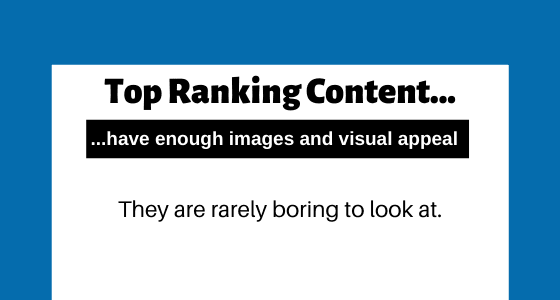
High-ranking content are rarely boring to look at.
One of the reasons behind that is they have enough visual “breaks” in between that prevents readers from feeling bored and overwhelmed with all the text information thrown at them.
This allows users the time to breathe and continue consuming the content.
Moreover, psychologically speaking, colorful images and graphics in between texts re-hook the fading attention of the readers, keeping them glued to the content.
High-ranking websites tout high average session duration. Among many reasons why, one is their visuals.
Good looking designs and graphics make consuming content and browsing the site much more appealing.
Recommended Read:
3. Keywords in the right places
Just including keywords in your content isn’t sufficient.
Where you place your keywords matters too – albeit very minutely.
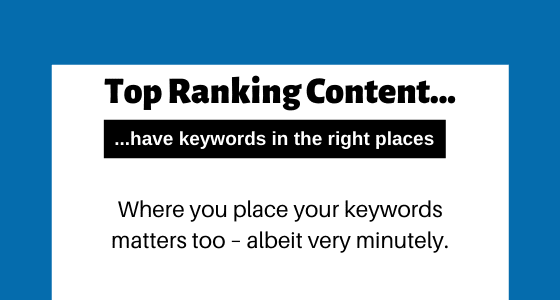
The headline must have the primary keyword in it. Preferably, if the headline can start with the keyword, even better.
For example: Choose “Content Marketing Strategy: 5 Tips for Startups to Dominate the Market” over “5 Tips For Startups to Create Content Marketing Strategy”.
Obviously, you must include your keywords in the Meta tag. Try your secondary and LSI keywords here to avoid making the description look spammy and keyword-stuffed.
You should use the primary keywords at least once within the first 100 words of the content.
Within the content, all the sub-headings should contain some variations of the keyword.
While some many say such detailed efforts around keyword placement are outdated, such measures are still prevalent among the high-ranking content.
4. Catchy (and promising) headlines
The power of a good headline could not be overstated.
If your headline is poor, even when your URL is ranking higher on SERP, fewer people will click on it.

And given Click-Through Rate (CTR) is one of the key ranking factors, poor click would eventually push your ranking down on SERP.
Almost all the top results have incredible headlines.
They don’t just give you a proper idea of what the content is about, but they are also equally catchy and promising.
Of course, coming up with such creative and kickass headlines is challenging. With limited space, there’s only so much you can fit.
I’ve written a separate post around this topic. Read: Write Clickable Headlines: 9 Best Practices For Bloggers
5. Easy to read and understand
No fancy words. No ‘hey look, I am such a good writer’. No leaving users to figure out themselves.
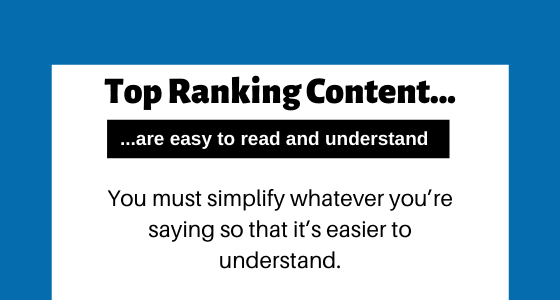
The top-ranking content are not only easy to read, but they are also easy to understand and extract learning value from.
They are clear in context, making even difficult theories simpler to grasp.
This is why people spend more time on the page to consume the content thoroughly; else they would have left if they didn’t understand.
This is why the session duration of the page is usually high.
And this is why they rank higher.
The biggest intent of the content is to resolve users’ queries and provide them the right solution.
For this, there’s no other way – you must simplify whatever you’re saying so that it’s easier to understand. This is important to put your content in the right SEO and UXO position.
6. Engaging and friendly in tone
This is primarily for the blog posts. They are usually treated as the top of the funnel asset, which must be engaging and friendly in tone.
There are content that informs and educates.
And then there are content that informs, educates, entertains and connects.
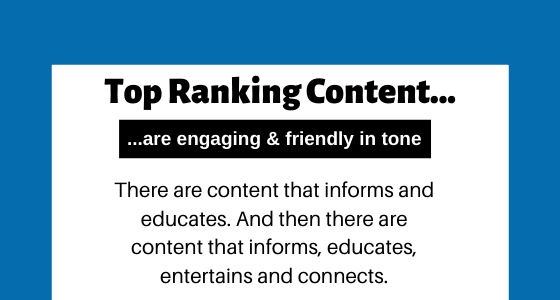
The latter is usually more preferred over the vanilla-type content that sounds like a robot. Because it exudes a personality. Because it sounds more interesting and is like a two-way conversation.
And since humans prefer such content more – so does the search engines.
This is why they consistently rank higher on SERP over the formal, robot-like copies.
Recommended Read: How to Make Your Content More Engaging? (15 Practical Ways)
7. Very well-structured
Running out of time and patient, many people won’t consume your content in entirety. They would just skim through it, picking the highlights and the “important parts”.
They can’t do this if your content isn’t structured well in unique headings, sub-headings, and sub-sub-headings.
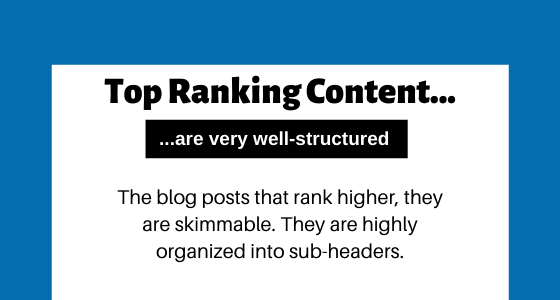
The blog posts that rank higher, they are skimmable. They are highly organized into different headers.
You can just go through the heads and sub-heads without confusion and get a fair idea of what the content is about.
This, then, helps many people decide whether they want to consume this content, bookmark it, spend more time on the page, or just leave.
And if the content is really of good quality and value, the users would decide to stay and consume more.
8. Cleanly formatted
In my opinion, this is a big mistake bloggers and content marketers make.
No matter how “incredible” your content is, if it’s not well-formatted, it will very certainly fail to impress the visitors. Meaning, they would eventually leave without engaging.
This is more prevalent in competitive niches where there are hundreds of blog posts just like yours.

The size of the font matters.
The font-family matters.
The weight of the font matters.
The line-height and letter spacing matter.
The paragraph change matters.
They all collectively make the page look clean and appealing to the eyes.
On the contrary, if the content is an endless number of lines, all squished together, where the person has to squint to read and ensure that she/he doesn’t lose track of which line they are on – it’s a bad piece of content.
It would deliver them bad UX.
The top-ranking content are easily consumable. They incorporate enough whitespace. They are easy on eyes. They are cleanly formatted that provide users a good experience.
9. Enough backlinks (internal and outbound)
The idea that if you link to other sites will leak your SEO/link juice is outdated.
Outbound link – where you link to other relevant websites – now help search engines better understand the context of your content.
And then, of course, when you link to other pieces of content on your own domain, it helps search spiders crawl your website better.
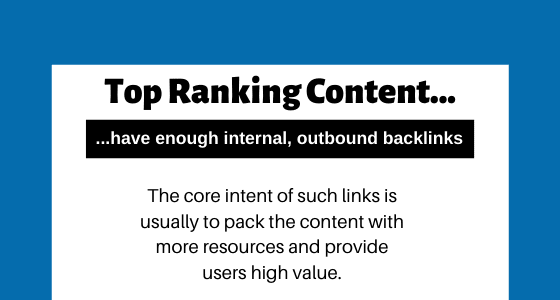
High-ranking content includes plenty of internal and outbound/external links through relevant anchor text.
The core intent of such links is usually to pack the content with more resources and provide users high value… something that search engines want you to do.
Here, give these two posts a read to know more about this particular topic:
10. Grammatically clean and correct
Rarely will you come across content ranking high on SERP with evident grammatical mistakes.
(Unless you’ve searched for something obscure and there’s a dearth in supply so Google will push any content that it comes across without considering its quality.)
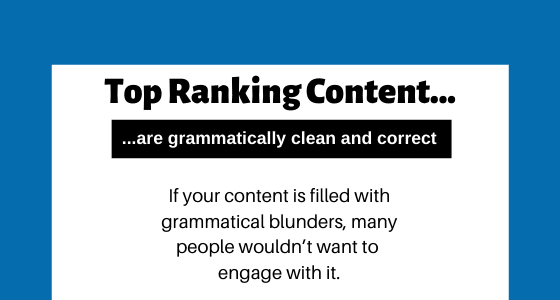
Now, correct grammar doesn’t necessarily affect search ranking directly. However, it does have an indirect say.
If your content is filled with grammatical blunders, many people wouldn’t want to engage with it. They would assume that it’s of poor quality, and then leave.
This will result in low session duration and a high bounce rate. Both of these metrics are key search ranking factors today.
This doesn’t mean only the grammar-Nazis can get content rank higher. It means, to maintain quality in content, avoiding big and evident grammatical blunders is important.
There’s a reason why Grammarly has emerged to be one of the favorite tools for bloggers and copywriters. If you don’t already, use it!
Read this: Grammarly Review 2019 – Thoughts of a Professional Copywriter
Also, give this a read if you have doubts about your writing skills: Do You Need to Have a Strong Writing Skill for Blogging?
11. Provides immense value
This goes without saying.
If they weren’t providing enough value, they wouldn’t be ranking high on the search result page, would they?
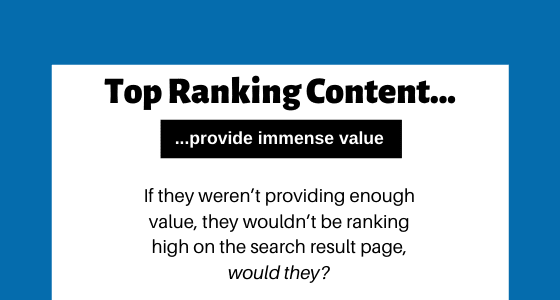
At times, you can find poor quality content at the top though. But they do not stay there for long. Once Google has enough data to understand their quality (through CTR, engagement patterns and more), they eventually get demoted.
These are 11 on-page attributes of high-ranking content.
This is far from a comprehensive list, but they are the common traits that are very apparent and fundamental of superstar content that search engines love.
Now, on to the next part…
15 Tips to Create Content That’s Optimized for Search Engines
The simple approach is to follow the above-mentioned attributes of the high-ranking content…1. Very high quality
2. Enough images and visual appeal
3. Keywords in the right places
4. Catchy (and promising) headlines
5. Easy to read and understand
6. Engaging and friendly in tone
7. Very well-structured
8. Cleanly formatted
9. Enough backlinks (internal and outbound)
10. Grammatically clean and correct
11. Provides immense value
Create content with similar traits… You will definitely get the search-engine-love that you’re looking for.
But, in addition, to help you get an edge and enjoy better (and faster) results, here are 15 tips to create content that’s highly optimized for search engines.
1. Include keywords in the first 100 words

This is one of the things I learned from Brian Dean of Backlinko. Go through his content and you will find his posts usually include the primary keywords in the first few lines.
The idea is simple – you want to give search spiders a fair idea about what the content is about as quickly as possible.
While there’s no empirical data that suggests this actually works, given Brian Dean is one of the biggest names in the SEO world, we can take his words (and actions) at face value.
So, include your primary keywords in the first 100 words of your content.
However, note to avoid awkward and forced queries like “lose weight quickly how to”.
It’s grammatically incorrect and doesn’t sound good.
It might help you win brownie points in front of the search spiders, it’s definitely something your human readers won’t like. And there’s some chance that they might leave immediately.
2. Follow the E-A-T protocol
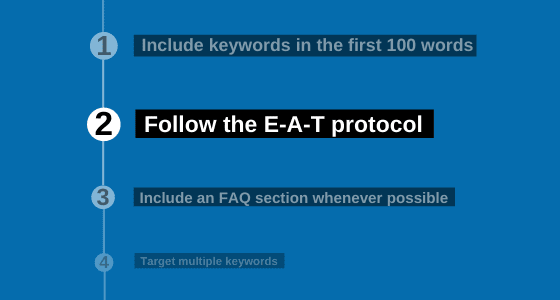
Google has made it fairly clear that it rewards content that follows the E-A-T protocol.
It stands for Expertise, Authoritativeness, Trustworthiness.
Generally put, Google uses several factors to rate page quality.
E-A-T is one of those factors that’s prioritized above all when analyzing sites that especially deal with healthcare and finance.
In order to perform better on SERP, your content must have all these three elements.
It must have expert insights. It must be authoritative. It must be trustworthy.
Of course, establishing expertise, authority and trust are quite vague. It takes time. Moreover, it has to do with the whole domain and not necessarily just one piece of content.
For example, a website with high Domain Authority can get a thin piece of content rank higher on SERP for a short period.
Because it’s not easy to measure E-A-T.
- Optimize content with keywords and phrases that address the intent of your target audience.
- Cover a topic from head-to-toe so that the content feels like an “ultimate” destination to learn everything about that topic.
- Deliver more than what a reader is here for.
- Include statistics and facts.
- Include relevant outbound links to authority websites. Even better if you can link sites with .edu and .gov extensions.
- Encourage people to share content on social media platforms.
- Make sure the site has a dedicated contact page and that it’s easy to contact you.
- Include the author’s name and a short bio.
- Have an SSL certificate; meaning, make sure your site is safe with HTTPS.
These are some of the ways to increase your Google E-A-T rating.
Aside from these, you want to continuously focus on your business or personal brand name to build authority and expert credibility.
And you want to continuously get back links from high-quality websites.
3. Include an FAQ section whenever possible
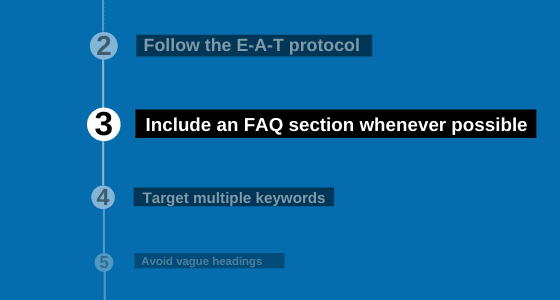
There are many benefits of adding a FAQ section within your blog posts.
- The questions directly and concisely address the needs and problems of the users. It enhances their experience.
- The questions provide the opportunity to include long-tail, question-based keywords in your content.
- It helps optimize your content for voice search.
- It increases the chances of getting your content featured in rich snippets and ‘People also ask’ section on SERP.
So, whenever possible, include a separate ‘frequently asked question’ section within your content; preferably at the very bottom.
4. Target multiple keywords
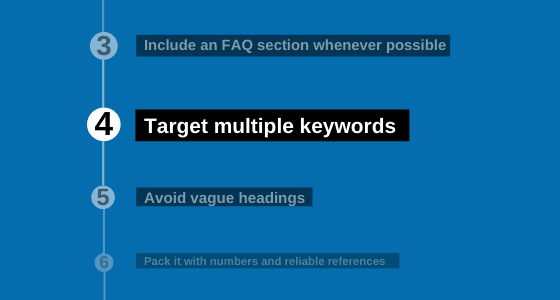
Of course, this doesn’t mean spamming your content with all the possible variables of your seed keyword.
However, you sure want to optimize the content with multiple keywords that target the same user-intent.
The long-tail keywords – which is exactly you should target – do not have high search volume.
Even if you manage to rank higher for that phrase, you shouldn’t expect a lot of visitors.
So, it makes sense to optimize your content with multiple long-tail keywords that accumulate you significant traffic from various search queries.
Moreover, targeting multiple keywords allows you to avoid redundancy in your content.
Using the same phrases every time can make content sound repetitive and boring.
5. Avoid vague headings

The headers within your content (H2, H3 and more)….
They not only provide a basic framework for your entire content, but they also play a key role in hooking the readers while they are skimming.
To that, if you’re writing a long content with too many sub-topics, you can address them only so much in your main headline. The rest should be promised in the sub-headings.
The point here is to write attractive sub-headings and sub-sub-headings that instantly grab the attention of the readers.
Avoid being vague, complicated and too fancy.
Something like “It is not good for your health (or is it?)” sounds good only in theories. In reality, go for something like “It is not good for your health – here are 3 reasons why”.
Keep it clean, straightforward, informative and interesting.
6. Pack it with numbers and reliable references
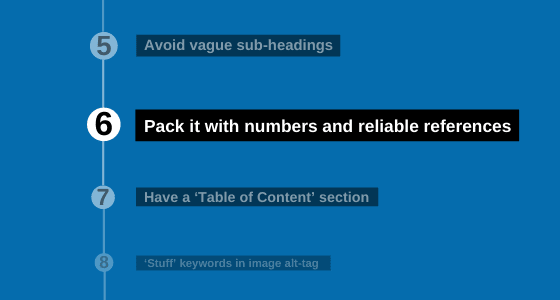
As mentioned in #2 point, you want to stash your content with definite numbers/stats and make reliable references. (And then you should link to those resources!)
This not only adds authority and trust value to your content, but it also adds to your brand credibility.
When you provide your readers with a well-researched post that is high in value, they appreciate it.
This cascades to positively affect your brand name, which then transcends into higher retention, engagement, and conversion.
They start trusting you more.
When they see your brand name, they not only recognize who you are but also realize the high value you bring to them.
All these eventually end up helping your search ranking.
Indeed, it might sound quite exaggerated. But a small measure like this when creating your content really makes a big difference.
7. Have a ‘Table of Content’ section
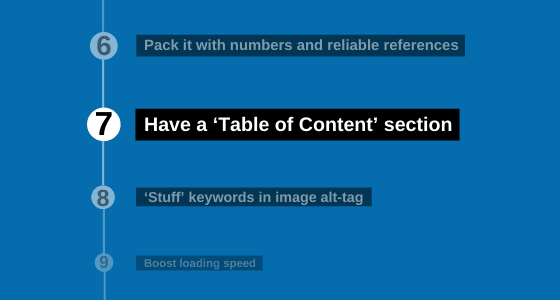
If you have created an in-depth, highly-comprehensive content, it would likely be very long.
So, there’s a good chance that a visitor would not consume this piece end-to-end.
They would first skim through it to understand the structure of the content and the sub-topics it has covered. And then they would consume the parts that they find relevant.
You can make this much simpler for your readers, which would then enhance their experience.
Just add a ‘Table of Content’ section at the top of the content.
And if possible, make the points in this table anchors, wherein when someone clicks on it, they are scrolled down to that exact part within that content.
In the end, this would make a big difference in your session duration and bounce rate, helping you with SEO ranking.
8. ‘Stuff’ keywords in image alt-tag
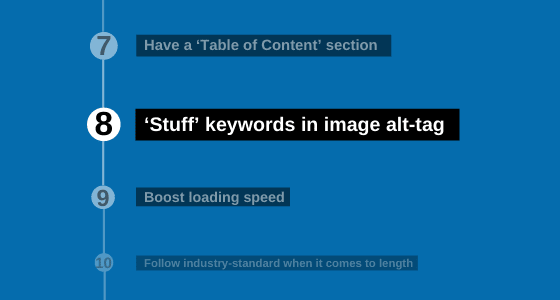
There are many benefits of using more images throughout your content. One of them is this…
It allows you more space to include your keywords.
In the image title, include your medium-tail keywords. But in the alt-tag, include more descriptive, long-tail, exact-match keywords.
Of course, do not over-extend or overdo this. But these are the little places where keyword “stuffing” is still okay! 😉
9. Boost loading speed
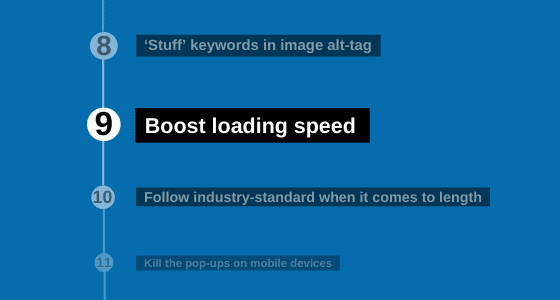
If you notice, I don’t have a comment section here on Spell Out Marketing.
I had Disqus, but I removed it.
One, because I wasn’t getting too many comments.
Two, because it was slowing down the site by micro-seconds.
Yep, that’s how important the speed of the site is.
In fact, just 1 second delay in page load time can lead to 11 percent loss of page views and a 7 percent drop in conversion. (Source)
Sites that load in five seconds – compared to those that load in 19 seconds – see 70 percent longer average sessions. (Source)
And then, per a survey, there are more evident numbers like…
- 47 percent of consumers expect a webpage to load in 2 seconds or less.
- 40 percent of consumers will wait no more than three seconds for a webpage to render before abandoning the site.
(Source)
In short, website speed has emerged to be one of the most important search ranking factors.
So, while generally, you must ensure your whole site is fast, you should make sure the content on the landing pages are lightweight.
For instance, using heavy graphics/images and third-party scripts in your content can make the page load slow.
So, minimizing the size of images before uploading them is crucial.
Instead of directly uploading videos on your page, embedding it from the likes of YouTube is a much better option.
You also want to avoid using scripts from unreliable sources.
I have discussed about website speed and SEO in-depth in another post. If you want, give this a read: Website Speed in SEO – Does Your Site Load in 2 Seconds?
10. Follow industry-standard when it comes to length
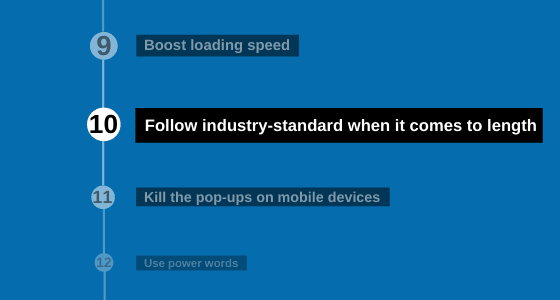
I am not particularly a big fan of blindly creating longer content. Hence these posts…
- The Myth of 1,890 Words Long Articles: Long-Form Content and SEO
- The Problems of Writing Long Blog Post
Yes, long-form blog posts consistently rank higher on SERP.
But then it also comes in direct contradiction to good user experience.
People don’t have a lot of time and attention to read a 15-minute long post.
In fact, there’s a good chance that 90 percent of visitors won’t read this long-ass post on SEO writing in entirety.
Moreover, the length of the content is far from being a ranking factor. And it isn’t any indicator of the quality and value of the content.
Even in limited words, a person can bring more value.
And with proper internal link building and on-page media, he can champion key SEO factors like bounce rate and session duration.
So, the bottom line is that you should keep the length of your blog post only as much as it’s needed.
But when it comes to ranking at the top of search result pages, the real answer is with your competitors.
What’s the length of their content?
Find out and follow the same standard.
Going too short or too long than the length of the posts that are ranking high already for your targeted keywords isn’t a very wise idea. (Unless you enjoy good brand value!)
So, Google your seed keyword and visit the first 20 results individually. Figure out the average length of the content and stick to that mark.
11. Kill the pop-ups on mobile devices
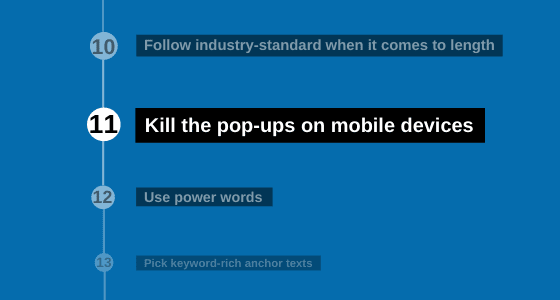
Pop-ups were cute. And they converted well (and still do).
But now they are more like a UX-disrupter… at least on small devices.
So, unless it’s essential, kill your full-page pop-ups.
Obstructing visitors from consuming the content hinders their experience. (And if you’ve got a bad copy/proposition in that pop-up, it makes the situation even worse.)
This increases the chances of them leaving your site quickly, negatively affecting your bounce rate and dwell time.
Recommended Read: How to Increase Website Dwell Time? (Here’s a Practical Guide)
But if you’re going to use a pop-up any way, use ‘Exit Intent’ pop-up. It shows when a person is leaving your site.
Since they are already leaving, it would matter less how intrusive this pop-up is.
According to Ericsson, by 2022, mobile traffic generated from smartphones is estimated to increase by 10 times.
So, you’ve got to be careful about the experience of mobile users.
Popups when a person is consuming your content – on a small device where clicking that ‘Cancel’ button isn’t easy – leaves a bad taste.
12. Use power words
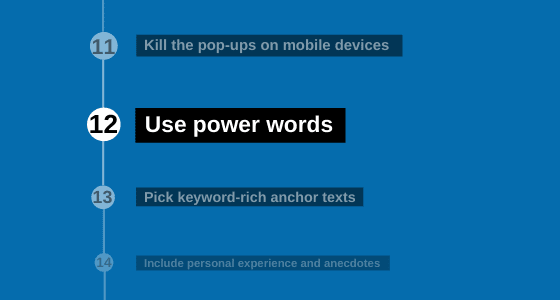
“Stuffs” “Whatever” “I was like…” “I guess” “Literally” “Amazing”
Such weak words and phrases negatively affect the credibility of your content.
When you’re trying to be an authority on any given topic, you shouldn’t say “In my opinion…” or “I feel…” It reflects a lack of conviction in what you’re saying.
You can’t use “other stuff”. It makes you look like you don’t know the lingos of your own industry.
Now, this doesn’t mean you have to craft the most perfect sentences and look like a great writer.
You simply want to avoid the words and phrases that would hit your credibility – that would make you look juvenile and as someone who doesn’t know what she/he is talking about.
Of course, keep the blog posts engaging and informal. But, from time-to-time, be sure to toss in some industry-standard words wherever needed.
To that, also regularly use powerful words – over the generic ones that we use in our every day – that are more interesting, impactful and confident.
Deadly, excellent, insanely, astounding, marvelous, extraordinary, staggering, stimulating, luxurious…
There are so many words. Indeed, you can’t learn or remember them all.
A simple trick is to keep an eye on the words you’re actually using. Whenever you spot a weak word, use thesaurus to replace it with something powerful.
Pay special attention to your headlines, sub-headings, CTA texts, author bios, and important landing pages.
Note: Use thesaurus carefully though. Some words might completely alter the meaning of the sentences.
Another simple trick is to go through the content of top competitors on the same topic you’re covering.
Crowd-source the words that you feel are strong and impactful. And then sprinkle them across your content.
13. Pick keyword-rich anchor texts

“Click Here” “Go Here” – not only are these prompts boring but they also give no detail to search spiders about what’s this link is about.
In particular, when linking to your internal pages, you want your anchor texts to be descriptive and keyword-rich.
A simple rule here is to use long-tail keywords of the target page that you want it to rank higher for on SERP.
Some of the points to remember…
- Avoid using the same anchor text on any given page for more than once.
- Make sure the anchor text is relevant to the target page.
- Use the words/phrases that are included in the URL of the target page.
- Avoid generic phrases. Make the anchor text adequately long.
- Do not use awkward, incorrect exact-match keywords. You’re writing this anchor text for humans. Plus, Google and Bing can understand that “SEO Checklist 2019” and “SEO Checklist for 2019” are basically the same.
Take your time in anchor text optimization.
It will help search spiders better understand the context of your pages.
Plus, thoughtful anchor texts can be quite helpful in navigating the users to different pages, which will then positively affect your bounce rate and session duration.
14. Include personal experience and anecdotes
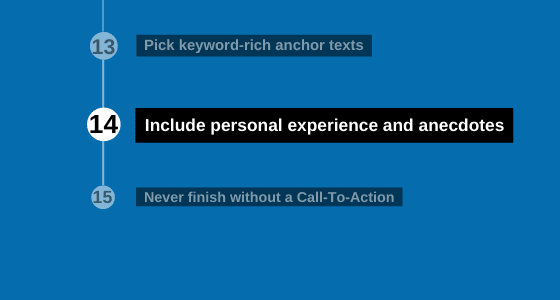
Here’s something that may disappoint you…
The blog post you’re writing right now, hundreds of your competitors – if not thousands – have already written and published the same exact thing.
So, when you publish your post, you would be joining a large crowd where everyone looks the same.
Remember, information is a commodity. Everyone has that – and everyone can share it. Personal experience is what that separates one from the others.
So, if you can add your personal experience and anecdotes in the otherwise commoditized information that you’re sharing, you can easily outstand the crowd of competitors.
And let’s not forget, that’s also the cornerstone of a strong brand.
Every person you know of that has high brand value, they don’t just bring you information – they bring you their experience.
This is why, if you’re building a personal brand, outsourcing people to write content for you or post on social media platforms on your behalf is a bad idea.
Sadly, the agency where I work in, we get many clients who commit this same mistake, not realizing that their vanilla digital presence that lacks personal touch or personality won’t sustain for long.
So, in your content, whenever it fits, include your personal experience and anecdotes.
If your niche allows, get comfortable using “I” and “me”.
People connect with personalized content. They love stories. They want to hear others’ experience that connects with their problems and circumstances.
This is a very powerful way to boost your reader retention and build brand.
And these, in the long run, will increase your organic traffic from search engines.
15. Never finish without a Call-To-Action
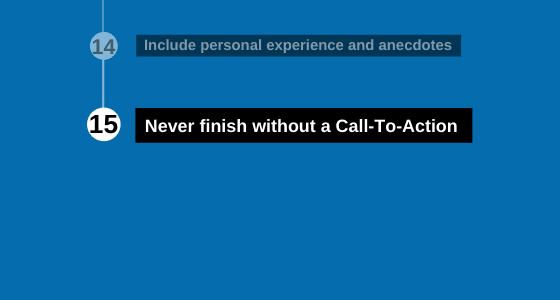
Undoubtedly, not every content you produce should aim to sell or make you money.
For that matter, almost all of your Top and Middle of the Funnel Content should be without any promotion.
However, every piece of published content must have a purpose. And to meet that purpose, they must end with a definite call-to-action.
You want your readers to leave the site knowing that they learned something – that they got some value in return for the time they spent engaging with your content.
So, it’s essential that they have some “takeaways” before they leave the site.
It’s important that they take action on the site that psychologically makes them believe about the good experience they had on this site.
In the end, tell your readers what you want them to do now. What action they should take now that would help them get closer to the solution of their problems.
Don’t just give them information. Also, instruct them on how to properly use that information.
The CTA could be anything – subscribe to your email to receive exclusive emails, to follow you on social media, to email you for personalized help.
No matter what the CTA is, while it will certainly boost your conversion, it will also add to your brand value.
One way or another, you can improve your brand visibility, retention and site’s direct traffic.
All these will add to help you boost your search ranking.
How to Get Your Content Rank on Top of Google?
Sometimes just writing SEO-friendly content isn’t adequate to rank at the top.Your competitors are likely doing the same thing.
So, you’ve got to pull various other strings as well.
For example, you’ve got to work to get backlinks to that content from other good sites. You must also link relevant internal pages to this URL.
So, while the above tips and suggestions will help you create content that search engine loves, you must adopt a strategic approach to ensure search engines rank that content quickly.
Think of it in this way: You can either wait and hope that Google will rank your content higher OR you can work some more to give it even more reasons to reward you comparatively quicker.
Makes sense?
At large, the process of getting your content rank higher can be split into five stages:
(i) Knowing your primary keyword
(ii) Running competitive analysis
(iii) Creating the “ideal” SEO content
(iv) “Pre-publish” work
(v) The on-going optimization and improvement
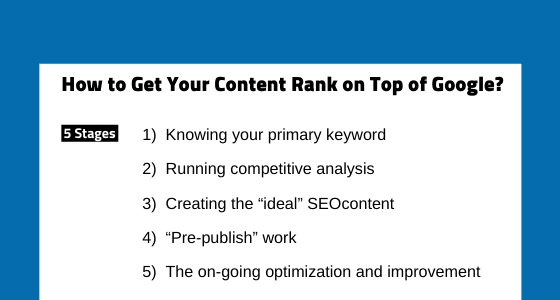
Let’s quickly run down these stages individually.
(i) Knowing your keywords
After you have the topic you want to write a blog post on, this is the first step in the process.
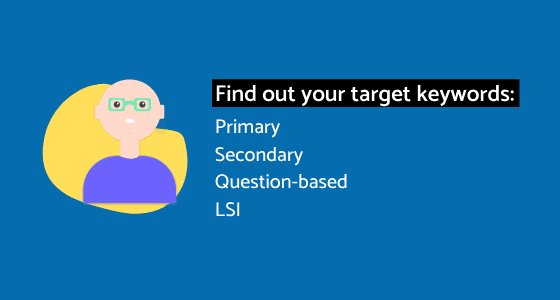
I wrote this on Spell Out Marketing – Insider. It’s a publication on Medium, an extension to this blog, Spell Out Marketing, where I regularly post bite-size, actionable articles around blogging and digital marketing. So, if you’re on Medium, please ‘Follow’ the publication.
Once you have the topic to write on, you want to know all your keywords: primary, secondary, question-based, LSI. This will help you create the framework of your content.
Keyword research does not have to take a lot of your time. Tools like Neil Patel’s Ubersuggest and KeywordTool.io make it fairly easy.
For more on this, please read:
Indeed, the relevance of keyword research is challenged by many today. But make no mistake: keywords remain very relevant.
A properly keyword-optimized content can leave even your high-DA competitors by miles, pushing you at the top of the results quickly.
(ii) Running competitive analysis
This is one of the most overlooked steps here.
When you realize that ranking higher on Google/Bing isn’t a hit-miss task – but rather very strategic that requires thorough planning – competitive analysis would start looking very important.

The idea is quite simple…
The keywords you’re looking to rank high for, you want to know about the websites that are already ranking for those keywords.
And then you want to do some research on those individual high-ranking results.
Like, you would want to know…
- The length of the content
- The number (and sources) of backlinks that page has got
- The number of images it has
- The keyword density
- Other keywords it is optimized for
- The number of social media shares it has got
And so forth.
Once you have such insights of your competitors who you are trying to overtake on SERP, you will have a better idea of how your own content should be.
Like, what should be the length of it, how many images should you aim to use, how many backlinks do you ideally want, what kind of websites should you approach for backlinks, which social media platform would drive you a better return, and more.
Again, toppling those high-ranking results isn’t a hit-miss task.
If you’re calculative in your approach, you can rank higher on SERP – even for highly competitive keywords – relatively quicker.
Knowing about your competitors is a big part of that calculative approach.
SEMrush is one of the top competitive research tools with many features and an insane amount of data.
Use it right away. Click here to try their competitive analysis tool.
I have also written an in-depth SEMrush review, answering whether the tool is worth spending or not. Read: SEMrush Review – Do you *Really* Need This Premium Tool?
(iii) Creating the “ideal” SEO content
After all the planning and plotting, time now for the main task…
Time now to create killer, highly-optimized content that search engines can’t help but love.
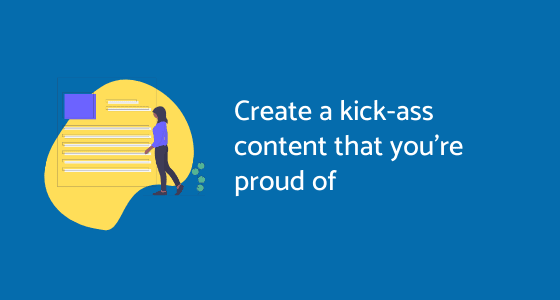
Nothing more here really… The above mentioned 11 traits of high-quality content, along with the 15 tips to create content that’s optimized for search engines, are more than enough to get you rolling and flying high.
Take your time here to produce a piece of content that you’re proud of – something that you’re satisfied with.
However, in the name of “quality” and trying to get it perfect, you don’t want to spend too much time in this stage either.
Focus more on speed than perfection.
Here are a few other resources that you might find helpful:
(iv) “Post-creation” or “Pre-publish” work
Once you have created a solid piece of content, don’t just rush to publish it. There are a few things that need to be taken care of before that.

Foremost, you need enough images.
More images not only provide you with the opportunity to include more exact-match keywords (in the alt-title), it also improves the chances of the post ranking high on Google Images.
So, include relevant images in your post, at a regular interval, to make whatever you’re saying more impactful.
Avoid picking “any” image from Google to avoid copyright issues. Use Pixabay(dot)com to find stock photos. Use Canva(dot)com to create your own images.
After images, time to include links in the post to make it more valuable.
Include links of the pages on your site (internal link), as well as the pages of others who are reputed (external).
Next, if needed, embed videos and tools on the page.
You also MUST format the content properly. A paragraph shouldn’t be more than three lines; use bold, italics and underline carefully.
Make sure there’s enough whitespace between the lines.
Then write an interesting and keyword-rich snippet for meta description.
Create the page’s URL that’s short and includes your primary keyword.
Recommended Read: 12 Meta Description Mistakes You Are Unknowingly Making
These are the basic things you must do – the right way – after you have completed creating your content, before publishing it.
(v) The on-going optimization and improvement
Your content won’t instantly rank on Google after publishing.
In fact, a study by Ahref founded that only 5.7 percent of all newly published pages get to Google top 10 within a year.
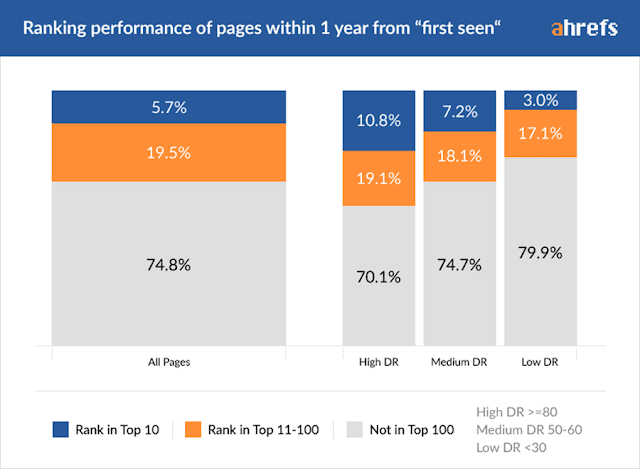
This doesn’t mean that it’s “very” difficult to get your new content higher on SERP, or that you have to wait for one year.
There are many different factors that influence the ranking of the published content. Some are uncontrollable, like the age of the domain and domain authority; others are controllable.
The on-going optimization and improvement part deals with these “controllable” factors.

After publishing, what more can you do to tell search engines that your content is a beast? What more can you do to tell them that it’s of superior quality?
I created a short article around this: 9 Things to Do (Immediately) After You Publish Your Blog Post. Give it a read.
Generally put, after publishing your content, you want it to have as many high-quality backlinks from top sites as you can.
You can do this by sending cold emails to others for backlinks, guest blogging on others’ sites, and several other ways.
Also, you want different relevant pages on your own domain linked to this newly published content.
Other than this, getting direct traffic also leaves a positive ripple in your search ranking.
For this, send email newsletters to your subscribers; regularly share post on social media; encourage visitors to share your content.
In the end, you also want to keep your eyes on Analytics to analyze the results.
For instance, if the bounce rate of that page is high, you might want to add more internal links there.
If the session duration is low, you might want to embed videos or increase the length of the content.
If one keyword is bringing you more traffic while other is performing poorly, you might want to revamp the content to focus more on the high-return keyword.
Analytics is important. It will help you understand how your content is performing. And with this information, you can further improve its performance.
I’ll end this section with this…
Oh, btw, if you aren’t already following Spell Out Marketing on Instagram, do it now. Go here to check out the timeline – it’s on fire! 😉
Career in SEO writing
In the real world, the agencies and clients do not care about the difference between SEO content writer, copywriter, and blogger.The lines between them are quite blurred.
So, while you might get hired as an “SEO content writer”, your role might stretch beyond.
You might end up creating content for various purposes – right from education and lead generation to sales and branding.
So, keeping your career scope narrowed to SEO writing might not be a very good idea – especially if you’re looking for enough opportunities and good growth.
You should explore different areas of web writing…
Grow your skills to adapt to different forms and purposes of writing.
Know how to write SEO friendly content. But also know…
- How to create branded content
- How to create copies that generate leads
- How to create content for social media that drives engagement
- How to write sales copies
- How to write Press Release, newsletters, and other communication materials
- How to be a blogger who also knows a thing or two about different forms of content
You very certainly can specialize in any one that suits your interest, like SEO writing.
But to remain competitive in the job market and find better opportunities, it is best that you’re a full-stack marketing writer or content creator.
Conclusion
In the end, although you’re trying to woo the search engine with your content – you should never forget that you’re creating this content for humans.Your focus should be on “how the readers will like this” and not “how Google will like it”.
Honestly, put it all together, SEO content writing is fairly simple.
If you’re a decent writer or blogger, you wouldn’t have much of a problem here.
I hope this post answered all your questions around SEO writing and provided you with actionable insights on how to create search engine friendly content.
If it did, please share it on social media to help others find it. It would mean a lot to me! 🙂
Recommended Read: Digital Marketing Guide for SMEs During Recession
